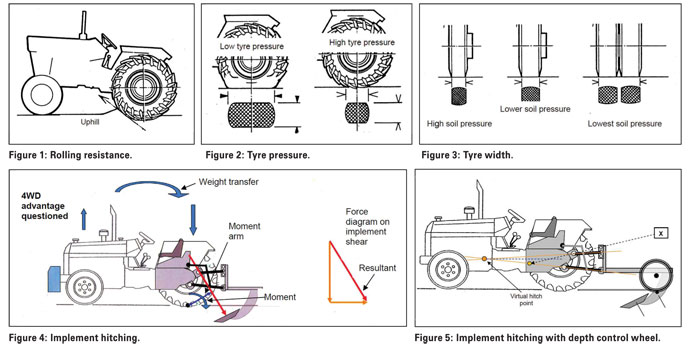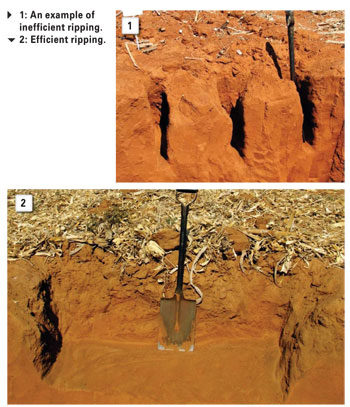August 2017
JOHAN VAN BILJON and DR TINGMIN YU, ARC-Agricultural Engineering
Why is ripping necessary? When tractor and implements are used, soil compaction may take place because of the texture of the soil and plough-pan effect by heavy weight of large scale machinery. Soil compaction prevents the root development of plants and planted crops.
Soil compaction can be solved mechanically or biologically. With mechanical action, ripping is the most common practical method used to loosen the soil deeply through a rip action. This gives plant roots a chance to develop well, which produces healthy plants and good crops.
Drawbar power required
A rip operation, however, is an action that requires a lot of traction and energy. It therefore is very expensive, so it is important to do the operation as effectively as possible.
Traction efficiency
Traction efficiency can be defined as the optimal utilisation of the tractor’s traction on a specific implement. However, there are a number of factors that can affect effective traction.
Rolling resistance
Rolling resistance (Figure 1) is the resistance the tractor has to overcome to move forward before any traction takes place. The factors that affect rolling resistance are soil hardness, the ground pressure that takes place under the wheels and the load.
Wheel load
Wheel weight load also plays an important role in effective traction, but must be used in accordance with the tractor manufacturer’s requirements. If the wheel weight load is too heavy, it may also result in traction disadvantages.
Graph 1 shows traction against 15% wheel slip with changed wheel load. The graph indicates that the pulling force is reduced when too much wheel-weight load is applied in soft soil.
Tyre pressure
Tyre pressure (Figure 2) also plays an important role in improving traction. Again, it is important to follow the tractor manual for the correct tyre pressure. Lower tyre pressure will allow greater traction and a bigger contact area to the soil, but can also lead to greater rolling resistance.

Tyre width
The use of wider or double wheels will enlarge the tyre contact area on the soil and therefore better traction (Figure 3). Wider tyres will also reduce soil compacting.
Wheel slip
A certain percentage of wheel slip is required for good traction. During wheel slip, the ground particles are compressed to create traction.
However, there is an optimum wheel slip percentage for different soil types. A too high wheel slip can reduce traction and also increase fuel consumption. Graph 2 shows that maximum traction power takes place at optimal wheel slip.
Implement hitching system:Three-point linkage
The resulting pulling force is perpendicular to the ripper tine shears. The pulling force is at an angle downwards at the back of the tractor and the moment is around the rear axle of the tractor wheels. This causes more traction on the rear wheels, but tends to lift the tractor’s nose and front wheels (Figure 4).
This can be a disadvantage for four-wheel drive tractors, because of the traction losses at the front wheels of the tractor.

Implement hitching system: Three-point linkage with depth control wheels
When using a depth control wheel on the implement, the force moment is between the centre of the ripper shears and the depth control wheel axle. This causes a downward pressure on both the rear wheels and front wheels of the tractor. In this way, better traction will be obtained over the front and rear wheels of the tractor, so a fourwheel drive tractor will deliver good traction (Figure 5).
Different types of rippers
Rippers come in different shapes. The main differences are ripper teeth shapes, some straight teeth designs and some with an arc shape. Ripper teeth designs differ from each other because manufacturers try to create the best design for their product for best soil penetration.
Then there are also the different ripper teeth shears that are being used. The shears of course help to effectively loosen the soil. Manufacturers come with different ideas of shear designs to loosen the soil. In most cases, the ripper shears are mounted at an angle to achieve better penetration.
The other important component that is sometimes added is depth control wheels, especially on the larger ripper frames. The function of the depth control wheels is of course for more effective depth control, but also to balance the weight and traction between the tractor’s front and rear wheels, which is ideal for four-wheel drive tractors or tractors with belt tyres.
Ripping efficiency
Rip processing is not a cheap operation, so it’s important to do the operation as effectively as possible. The purpose of a ripping operation is to loosen the soil or break a plough-pan layer. Effective ripping can only be done when the maximum volume of soil is released. The energy input must therefore justify the output.
Several tests have already been done on different soil types and it has been found that not all rip actions are effectively done. The effectiveness of the ripping depends largely on the soil type, soil clay percentage and moisture percentage. The mechanical differences will, of course, depend on the working depth, working speed, shear type and shear cutting angle.
Photo 1 is an example of an inefficient rip operation where the soil is not properly loosened. Photo 2 shows an effective ripping process because the volume of soil is more effectively loosened. Thus, the amount of energy used to do the work is better utilised.
Drawbar power needed for rippers
The pulling force required for rippers is generally very high, but will depend on the soil type, ripper teeth design and shear design. Of course, the ripping depth will also play a role. The question is, what is the optimal working depth because the deeper the ripping action, the higher the power demand.
Ripping depth will depend on the specific need, whether it is to break a plough-pan, or because of very sandy soil which need to be ripped every year because of the characteristics of the soil.
Shear design, shear working angle, shear width and placement of shears will also have an effect on the energy consumption. Tests have been done with different shear angles versus the drawbar power required.
It was found that the higher the shear angle with the horizontal, the higher the drawbar power needed because of more soil disturbance taking place at higher shear angles.
Implement efficiency improved rapidly by increasing the ripper shear angle on the ripper tine. This is due to the fact that better and more efficient loosening of soil takes place. Again the amount of drawbar power is better utilised.
Spring tension setting of the ripper tine
Some rippers are designed with an auto release mechanism on the tines which operate against a spring tension. The purpose of the ripper tine spring is to safeguard the ripper tine when hitting a rock or hard pan in the field.
The spring tension setting will normally vary according to the soil type and conditions. It is important to check the ripper manufacturer’s manual and set it accordingly. When the setting is not correctly done it may either damage the ripper tine or have an impact on ripper depth control.
Conclusion
When a sub-soiler or ripper needs to be utilised, the following factors can be considered with regards to the operational efficiency:
- Optimal traction efficiency of the tractor.
- Different types of soil such as sand, clay, loam or combination of different components.
- Soil physical properties such as moisture content and bulk density.
- Number of ripping shanks.
- Plough-pan and optimum ripping depths.
- Shear design parameters such as shear working angle, shear width and placement of shears.
- Make sure to correctly set the spring tension on the ripper tines for correct operation purposes.
Contact details
Information regarding this article on test results is available from ARC-Agricultural Engineering. Contact Johan van Biljon at vbiljonj@arc.agric.za or 012 842 4000 or Dr Tingmin Yu at YuT@arc.agric.za or 012 842 4090.
Publication: August 2017
Section: Focus on

















